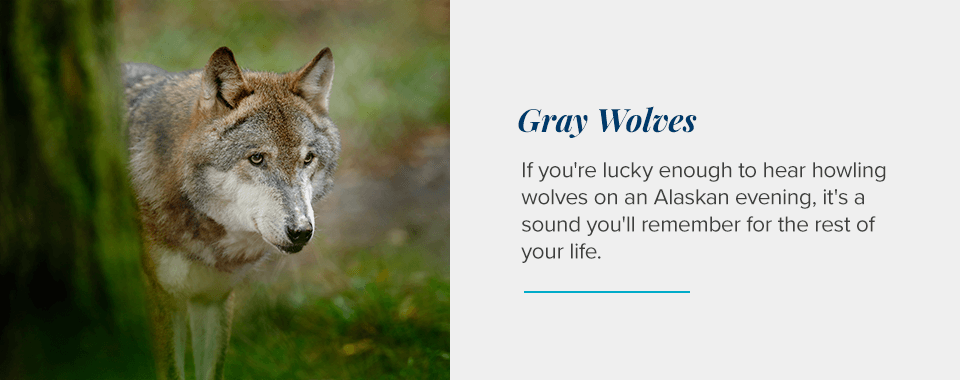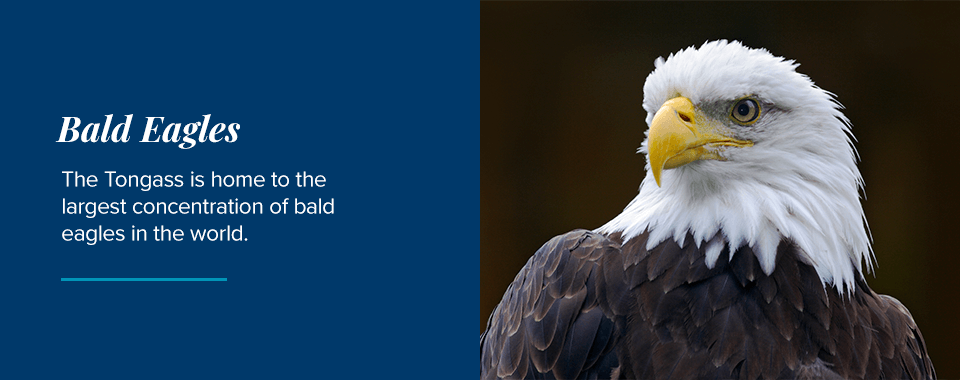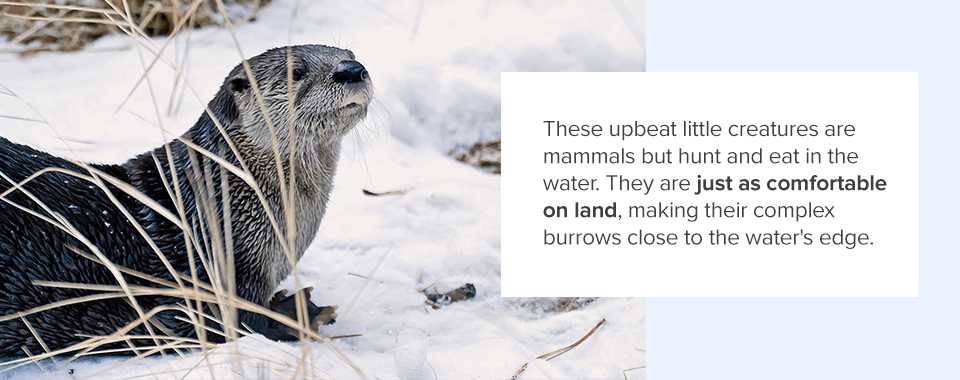
Southeast Alaska is known for its unparalleled views, rustic local charm and unique national forests. According to the Forest Service, the Tongass National Forest is the largest in the United States and the largest intact temperate rainforest in the world. As you journey through some of the 17 million acres of the Tongass National Forest, you can enjoy the tranquility of roadless areas, the 800-year-old trees and the endangered wildlife.
A visit to this ancient oasis for endangered animal species grants you a once-in-a-lifetime opportunity to see them in their natural habitat. The animals in the Tongass National Forest live as nature intended them to — in perfect symbiosis with their majestic surroundings. Visitors may come across bears, wolves, salmon and various bird species, making this the ideal escape for the avid nature lover. Let’s take a closer look at some Tongass National Forest animals.
In This Article
- Land Mammals of the Tongass National Forest
- Birdlife in the Tongass National Forest
- Marine and River Life in the Tongass National Forest
- Plan Your Trip to Alaska With Windstar Cruises Today
Land Mammals of the Tongass National Forest
There are almost countless species of land mammals to be found as you tread through the depths of old-growth forests. From predators to prey, small to large, the forest is awash with movement and the sounds of natural life. Should you choose to visit, some of the land mammals you may come across are:
1. Black and Brown Bears
In many ways, the Tongass National Forest is heavenly for both bear species — so much so that the bears outnumber the people in parts of the forest.
North American brown bears, commonly known as grizzly bears, are a massive species. The Alaskan brown bear is the largest of all brown bears and can weigh between 500 and 1,500 pounds, depending on its location and the time of year. You can identify a brown bear with the characteristic muscular hump between its shoulders.
These bears are omnivorous and eat a wide variety of berries, roots, carrion, salmon and other prey animals. Although they tend toward scavenging, they can eat deer and moose if they choose. They eat a lot during the spring and summer months to build fat reserves for the five- to eight-month-long hibernation in the winter.
You can see these bears roaming, hunting, climbing trees or swimming in the Tongass rivers.
Black bears are similar to brown bears, though smaller. As their name suggests, their fur is black, but they do have brown markings on their muzzles. Their diet is the same as their brown counterparts, but as they are smaller in stature, they don’t hunt larger game like moose and elk.
2. Gray Wolves

These elusive predators are a sight to behold and a true symbol of the wilderness. Though they’re critically endangered, it’s still possible to catch a sighting in the Tongass National Forest. In Alaska, the gray wolf, also known as the timber wolf, can weigh anywhere from 60 to 145 pounds.
Gray wolves are carnivorous and hunt in packs to bring down large prey. Most packs have between four and nine members and have a strict hierarchy. They communicate using body language and vocal sounds. If you’re lucky enough to hear howling wolves on an Alaskan evening, it’s a sound you’ll remember for the rest of your life.
3. Canadian Lynxes
Although these elusive members of the cat family are only slightly larger than housecats, they are accomplished, nocturnal predators. They shun human contact, so sightings are exceptional. You’ll know if you’ve spotted one by the characteristic black tufts on its ears and tail.
These cats feed almost exclusively on snowshoe hares. These two animals have evolved together — the hare, the master of evasion and the lynx, the master of the hunt. Should the hare population run short, you might find a lynx feasting on squirrels and other small rodents instead.
4. Red Foxes
Red foxes are abundant throughout Alaska and other parts of the United States. These adaptable canines are known for their red coat, white marking and black points, although they come in various colors. They might be on the shy side but aren’t entirely human-avoidant either.
While they are considerably smaller than other canine species in the Tongass, red foxes do well for themselves hunting small rodents and the occasional hare. They are incredibly agile and can jump up to 6 feet high. They can also sprint at up to 30 miles per hour. Red foxes are beautiful, athletic and a joy to view in their natural habitat.
5. Ermines
These cute little weasels are some of the most well-adapted animals on the planet. Should you visit Alaska in the spring or summer, keep your eye out for little, brown, weasel-like creatures scurrying around. In winter, however, their coat color changes to pure white to provide them protection from larger predators.
Ermines are predators themselves. They’re crafty, dexterous and known for taking down animals larger than they are. Although the ermine population is large, they are quiet and fast, so you have to pay close attention if you have any chance of spotting one in the wild.
6. Porcupines
They may not look like it, but these spunky little creatures are one of the largest rodents in Alaska, second to beavers. They are primarily nocturnal but can also be spotted foraging for herbivorous snacks during the day. They are stronger than they seem and have quills covering most of their bodies.
Porcupines are solitary creatures and spend most of their time in trees. They look dangerous, but they use their quills primarily to fight with other males for the chance to reproduce with a willing female. Don’t be fooled, though. If a porcupine is threatened, it’ll use those barbs to defend itself just as quickly.
7. Sitka Black-Tailed Deer
The black-tail deer is an integral part of the Alaskan rainforest. They are red to brown in the warmer months and adopt a gray-brown appearance in the winter. This gorgeous subspecies of the mule deer can be on the secretive side and feeds on herbaceous vegetation throughout the year.
Unlike many other deer species, the black-tailed deer is a solitary animal. They may graze together if necessary but do not form cohesive groups. For many, these deer make popular hunting trophies, as a full-grown one makes have impressive antlers and can weigh up to 200 pounds. Black-tail deer are good swimmers and can be found on several Alaskan Islands.
8. American Beaver
These semi-aquatic herbivores are the largest rodents in the U.S. and one of the only animals in the world to be considered a keystone species. Through the building of their dams, beavers can shape the ecosystem around them by building natural dams and wetlands.
Beavers can stay underwater for up to 15 minutes without resurfacing for air. They have transparent eyelids that act as goggles to see in muddy waters. These fascinating animals are also monogamous, so if you see a pair of beavers, you can enjoy the romance knowing that they mate for life.
9. Moose
Moose are the largest members of the deer family, and the Alaskan moose is the largest of all. These giant creatures can weigh anywhere between 800 and 1,600 pounds and stand 6 feet tall. Despite their size, they’re quiet herbivores that eat large quantities of aspen, willow and birch twigs. They’re grazers and browsers, so you could find them enjoying some crisp, green grass in the spring and summer.
Alaskan moose are renowned for their sizeable antlers but don’t often use them for self-defense. They have sharp hooves and massive kicking strength should they be faced with black bears or other predators. The antlers are reserved for the courting process and to claim territory.
Birdlife in the Tongass National Forest
There are plenty of animals to see on the ground when you’re in the Tongass, but don’t forget to look to the skies. If you’re a bird lover, you’ll delight in some of the stunning birds that call the Tongass National forest home.
10. Bald Eagles

The Tongass is home to the largest concentration of bald eagles in the world. Since 1782, the bald eagle has been a symbol of the United States and the country’s national bird. We are accustomed to seeing images of these mighty birds with brown bodies, white heads and yellow beaks, eyes and talons. Seeing them, in reality, is an entirely different matter.
Bald eagles are massive birds. The females are slightly larger than the males and can be up to 3 feet in length with 7 feet of wingspan. In part, they are drawn to the Tongass due to plentiful resources but prefer not to fish for themselves. They’ll wait for other birds to make a catch, and when they drop it in the air, the bald eagle will strike. Even mammals have to be on alert when Bald Eagles are close by.
11. Tufted Puffins
While they might be somewhat comical in appearance, these seabirds are hard-working and resilient. They spend most of their lives on the ocean and only come ashore when they’re raising young.
It’s easy to spot a tufted puffin with its oversized yellow beak and characteristic golden tufts. They are also known as crowned puffins due to these tufts, which can resemble a crown. These puffins are phenomenal swimmers and have been known to dive to depths of up to 250 feet. Flying doesn’t come as easy to them, though — they are heavy birds for their size, and taking off is strenuous.
12. Merlins
You’d be lucky to spot this shy falcon anywhere, but your chances are as good as any in the Tongass. These diminutive falcons may not look intimidating, but they’re fierce for their size. The feathers along the top of their back and wings are often dark gray or brown and lighter under the wings and stomach.
Merlins are energetic and stealthy predators and rely more on their ingenuity than larger falcon species. They are carnivorous and eat anything from insects to small mammals and birds. Watching a merlin hunt is a fantastic experience — they are incredibly agile in the air and ferocious for their size.
Marine and River Life in the Tongass National Forest
Water shapes the Tongass National Forest in many ways, making it perfect for the area to have spectacular river and marine life. Regardless of where you are, you’ll find plenty of water creatures that make the Tongass their home.
13. Salmon
Alaska and salmon go hand-in-hand, and the Tongass is no exception. Many people refer to the Tongass as America’s salmon forest. The Tongass is home to all five of North America’s Pacific salmon species, and the abundance of rivers, creeks and lakes provide ideal spawning conditions.
Salmon play an essential role in maintaining the Tongass ecosystem, according to the U.S. Forest Service. Not only do they provide food and employment for many in Southeast Alaska, but dozens of different animal species rely on salmon for nutrition. Salmon carry nitrogen upstream, which allows for the trees and other greenery to flourish, as well. The high commercial demand for salmon makes it even more of a privilege to see them in nature.
14. River Otters

The North American river otter represents fun and playfulness in the Tongass. These upbeat little creatures are mammals but hunt and eat in the water, making them an integral part of the forest’s river life. They are just as comfortable on land, making their complex burrows close to the water’s edge.
Otters are designed for swimming, with webbed feet, powerful tails, water-resistant fur and long whiskers to help them locate prey in low-visibility waters. They love to play when they’re not hunting fish and other river life. Familiar games include mud sliding, running up to 15 miles per hour and tail-chasing. Play is part of social bonding and helps teach young otters hunting behavior.
15. Orcas
Orcas and humpback whales abound along the Tongass coastline, and visitors often see them breaching and playing in the water.
Orcas, also known as killer whales, are the largest of the dolphin family and can reach up to 30 feet long. They’re known for their staggering intelligence and are one of the most powerful predators in the world. Easily recognizable by their distinct black and white markings, these fascinating creatures share strong familial bonds and advanced communication. They travel in pods and can make unique sounds, recognizable at a distance by other pod members.
Killer whales can travel long distances underwater but resurface to breathe, making them easy for travelers to spot.
Plan Your Trip to Alaska With Windstar Cruises Today

Alaska is the epitome of wild beauty, and a visit there will allow you to experience the wildlife, breathtaking scenery and local culture in a way that creates lifelong memories. There is nowhere like Alaska anywhere else on earth, and the Tongass National Forest is just one of many unbelievable experiences you can enjoy on an Alaskan cruise.
As the world changes, an opportunity to see some of these endangered species is becoming more precious every year. Let Windstar Cruises help make your dreams come true in a boutique, intimate cruise setting. Enjoy a relaxed and unpretentious ambiance and a dedicated crew who genuinely cares about their passengers. Experience everything Alaska offers in an intimate setting.
If you’d like to learn more about how to create your incredible Alaskan Cruise today, request a call from Windstar Cruises and let us help you tick another item off your bucket list and create lifelong memories in a unique, wildlife-rich setting.





